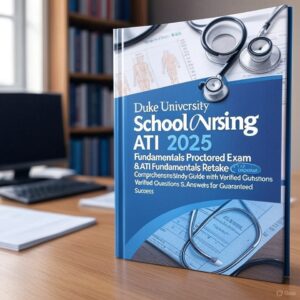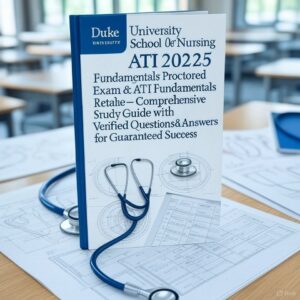-
Verified Questions & Answers: Accurate practice questions with detailed solutions.
-
Comprehensive Study Guide: Covers all ATI Fundamentals topics thoroughly.
-
Retake Support: Tailored materials for ATI Fundamentals retake preparation.
-
Duke-Specific: Designed for Duke University School of Nursing students.
-
Updated for 2025: Aligned with the latest ATI Fundamentals Proctored Exam standards.
Preview
1. A nurse is caring for a client who refuses to follow the provider’s prescription for bed rest.
The nurse overhears the assistive personnel (AP) tell the client that if she does not remain in
bed, he will place her in restraints. The nurse should identify that the AP is committing which
of the following torts? a. Libel
b. Defamation of character
c. Assault
d. Battery
Correct Answer: c. Assault
Rationale: Assault refers to a verbal or physical threat that makes a person fear harm, even if no
actual physical contact occurs. The AP’s statement is a threat that could cause the client to fear
being restrained, making this an example of assault.
2. A nurse is preparing to insert an IV catheter for an older adult client who has fragile skin.
Which of the following actions should the nurse take?
a. Stabilize the vein by applying traction above the insertion site
b. Engorge the vein by placing the arm in the dependent position
c. Use friction at the insertion site to increase venous distention
d. Leave the tourniquet on for 30 to 60 seconds after initial insertion
Correct Answer: b. Engorge the vein by placing the arm in the dependent position Rationale:
Placing the arm in a dependent position helps dilate the veins naturally by using gravity, making
venipuncture easier. This is especially important for older clients with fragile veins.
3. A nurse is planning care for a client who has a new prescription for parenteral
nutrition (PN) in 20% dextrose and fat emulsion. Which of the following is the
appropriate action to include in the plan of care? a. Prepare the client for a central
venous line
b. Change the PN infusion bag every 48 hours
c. Administer the PN and fat emulsion separately
d. Obtain a random blood glucose daily
Correct Answer: a. Prepare the client for a central venous line
Rationale: Parenteral nutrition with a high dextrose concentration (greater than 10%) requires
administration via a central venous line to prevent vein irritation and thrombosis.












Reviews
There are no reviews yet.